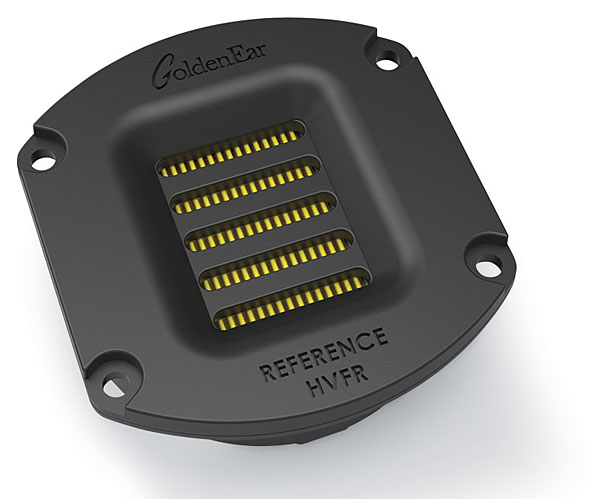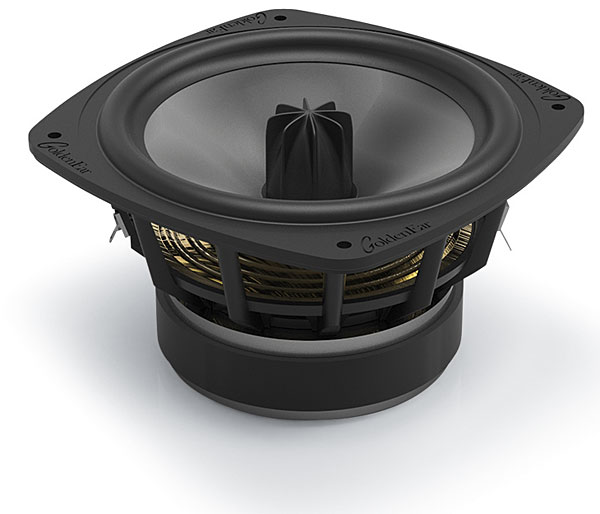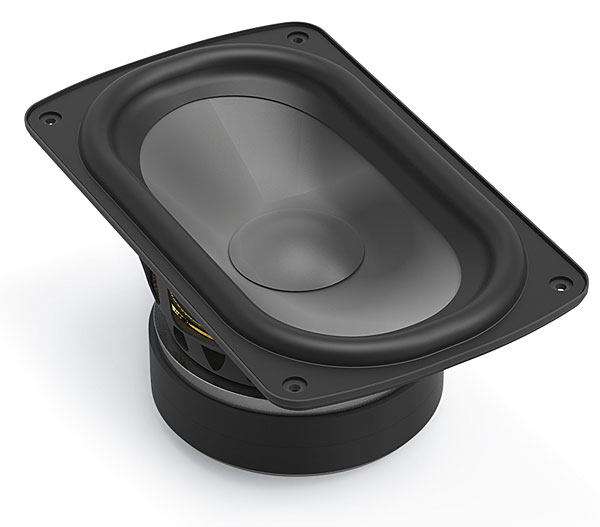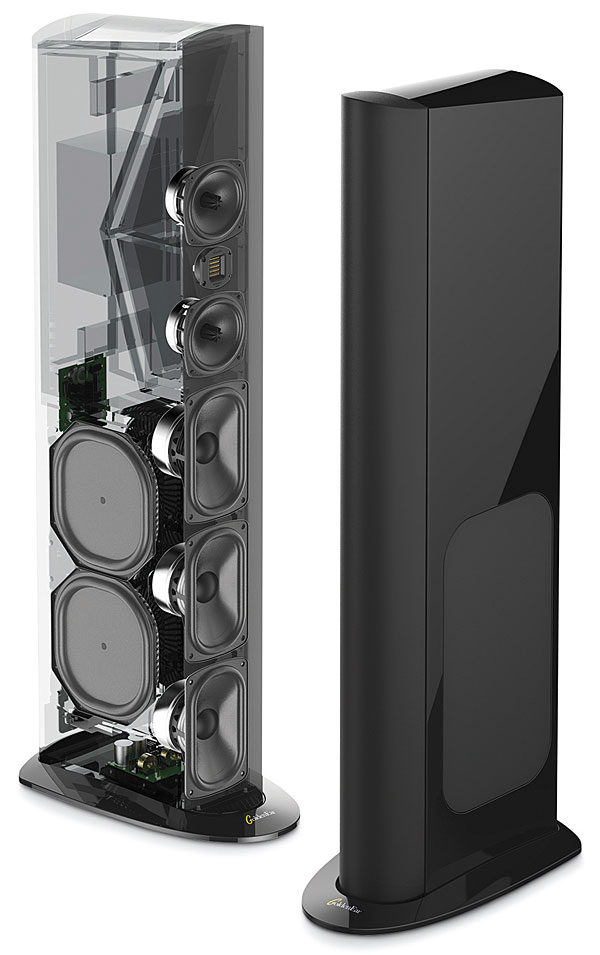By Al Griffin | Apr 4, 2017
With the Triton Reference, GoldenEar Technology has delivered their finest loudspeaker yet. It looks great, sounds great, and represents an exceptional value in high-end audio.
When I reviewed GoldenEar Technology’s debut loudspeaker, the Triton Two, shortly after the company launched in 2010, co-founder/president/polymath Sandy Gross indicated that it would be the first of many to come. He wasn’t exaggerating. New entries arrived thereafter in quick succession, including powered towers, passive towers, soundbars, subwoofers, bookshelf models, and in-ceiling speakers. And in 2014, the company introduced the Triton One. Priced at $2,500 each or $5,000 for the pair, it represented the pinnacle of GoldenEar’s mission to combine high performance with high value.
My take—and that of many others—was that the Triton One stood as a definitive put-up-or-shut-up challenge to an industry increasingly disposed to selling staggeringly expensive products. That’s why I was surprised when, less than two years later, Gross dropped news of another ace up his sleeve: a speaker that would take the technology the company had worked into the One and improve on it. And though he was willing to relax his value-oriented mindset to achieve his goals for the new speaker, it would still come in at under $10,000 for a pair, a number that, while pricey for the average consumer, seems almost a trifle these days against more than a dozen exotic high-end speakers ranging from over $100,000 to up to $1 million or more per pair.
GoldenEar’s more affordable entry is the new Triton Reference, whose sticker price of $4,249 each translates to $8,498 per pair. Like the One, the Reference is a powered tower with a combination of traditional passive woofers and tweeter, plus a trio of active sub-bass drivers augmented by a quartet of passive radiators to achieve true full-range sound reproduction. But for this new flagship, GoldenEar has introduced a number of enhancements large and small that, taken in total, help to justify the Reference’s exalted name.

Reference Quality
Starting from the highest frequencies reproduced by the Triton Reference and working our way down, those enhancements include a new version of GoldenEar’s HVFR tweeter with 50 percent more neodymium magnetic material, a tweak that increases efficiency and allows for better control of the tweeter’s pleated planar diaphragm. The volume of the chamber located behind the tweeter has also been enlarged, and there’s a smoother angle to the transition between faceplate and diaphragm that helps to improve dispersion.
The bass/midrange drivers above and below the tweeter are 6-inchers, as opposed to the 5.25-inch drivers on the Triton One, and they incorporate a new cone that uses a low-mass bonding to the surround, claimed to improve transient response. Also larger are the 6 x 10-inch drivers in the speaker’s subwoofer section, which provide 40 percent more surface area than the One’s drivers and feature a substantially bigger magnet structure and voice coil. The 1,800-watt specified, 56-bit-DSP-controlled amplifier powers the active drivers, which are aided and abetted by 10.25 x 9.5-inch passive “planar infrasonic radiators” arranged on either side in an inertially balanced configuration similar to that found in GoldenEar’s SuperSub X and XXL subwoofers.

Designing a reference-quality anything involves sweating over details, and it’s clear here that GoldenEar did just that. As with the One, the Reference’s customized crossover uses a fully balanced circuit. Damping material inside the speaker’s cabinet is made from a custom mixture of Dacron and long-fiber lamb’s wool. The speaker’s base incorporates a 3/32-inch steel plate that GoldenEar says provides a dramatic increase in stiffness and stability over that of the all-medite bases used on the company’s other models. More detail: The Reference comes with stainless-steel carpet spikes instead of the brass versions typically provided with tower speakers.
Additionally, much work was concentrated on the speaker’s internal bracing for maximum rigidity, according to Gross. While this isn’t readily visible, what is visible is the speaker’s single-piece gloss-black monocoque cabinet. A first for GoldenEar (which has wrapped all previous Tritons in a black-mesh “sock” material), this cabinet improves performance by enhancing the speaker’s overall rigidity and “deadness.” It looks great, too: While other speakers put out by the company have followed the same basic design template, the attention paid to cosmetics here makes the Reference really stand out from the GoldenEar pack.
Setting Up
 Standing nearly 5 feet high and weighing 110 pounds, the Triton Reference can’t help but dominate any space it’s placed in. Then again, as a speaker targeted at audiophiles, its likely home will be in a dedicated music or media room. (Given the number of drivers inside, it’s amazing how compact the cabinet actually is). I enlisted help to hoist a pair of the speakers into place, and I’d recommend that anyone else seek out the same.
Standing nearly 5 feet high and weighing 110 pounds, the Triton Reference can’t help but dominate any space it’s placed in. Then again, as a speaker targeted at audiophiles, its likely home will be in a dedicated music or media room. (Given the number of drivers inside, it’s amazing how compact the cabinet actually is). I enlisted help to hoist a pair of the speakers into place, and I’d recommend that anyone else seek out the same.
Setting the speakers up in my 17 x 20-foot listening room, which has a ceiling height of 9 feet, I positioned them about a foot out from the front wall and spread 9.5 feet apart, with each tower angled in toward the main listening seat. The specific area of the room where the speakers sat has a wood floor, so I used the included adjustable rubber feet to fine-tweak position, sloping the front baffles slightly forward to better align the HVFR tweeters with my head. Tweaking was carried out in the company of Gross, who then found time to take in a Picasso exhibit at the local art museum before flying out early to escape a blizzard.
Like other GoldenEar powered towers, the Reference features an RCA-jack LFE input on its lower back panel. This can be used to run a separate LFE subwoofer signal from a processor or receiver, which lets you tweak bass level using the processor’s or receiver’s remote control when the speakers are in a home theater setup. Since my test was primarily stereo-only, I simply connected my 80-watt-per-channel integrated amp to the speaker’s gold-plated binding-post inputs. (With efficiency spec’d at 93.25 decibels, the Reference was easy to drive to exceedingly loud levels; even a 60-wpc amp I swapped in at one point proved more than sufficient in my room.) Lastly, I left the Subwoofer Level dial on the back panel at its center setting, which provided plenty of bass to fill my approximately 3,000-cubic-foot listening room.
Listening Up
With so much effusive (and in some instances, over-the-top) praise having been heaped on the Triton One, I’m afraid that any nice comments I make about the Triton Reference may come off as inadequate. You’d think that with the One, GoldenEar had created a type of audio crack, as opposed to just a really good speaker. Anyway, here I go.
To begin and provide some frame of reference, I should note that I’m actually a GoldenEar owner: I was wowed enough by the Triton Two back when to buy my review pair. So I’m well aware of what the company’s speakers can do. They cast a panoramic, almost surround-sound-like image. Bass on the powered models, with their builtin subwoofers, is potent and low reaching. Vocals and acoustic instruments have a strikingly natural timbre. The HVFR tweeter (essentially a magnetic planar design despite the acronym standing for High Velocity Folded Ribbon) conveys exceptional detail while adding a sense of air and dynamic ease.
All good, right? One thing I left off that list is coherency—something I’d imagine is a particular challenge to achieve in a tower with a built-in subwoofer. The sound doesn’t seem to have anything missing from it, and in all the Tritons I’ve heard, the various frequency ranges flow together in a seamless manner.

All of these qualities were in evidence with the Triton Reference, and then some. When I listened to a CD cut of jazz man Charles Lloyd’s take on the traditional ballad “The Water Is Wide,” his saxophone sounded finely textured, full, and afloat in threedimensional space. Drums had an expansive, larger-than-life quality, with the shimmer of brushed cymbals expanding far into the horizontal and vertical planes. Meanwhile, the warm, liquid tone of Brad Mehldau’s piano came across intact, and Larry Grenadier’s standup bass displayed excellent extension and enough definition that I could visualize the strings being plucked.
Needing to hear more jazz, I played another CD cut, “Alabama,” from In Movement by Jack DeJohnette with Ravi Coltrane and Matthew Garrison. DeJohnette’s deft cymbal rolls sound crisp and airy on this track, and the Reference rendered them in a way that revealed the cymbals’ fine attack and decay as his sticks wandered from high-hat to ride and back again. Coltrane’s sax, too, came through with a palpable sense of air and ease as he ripped through the high registers of his instrument while running scales.
To get a quick sense of the speaker’s dynamic capabilities and see how it rendered a distinct female voice, I checked out a Tidal stream of “Under the Boardwalk” from Rickie Lee Jones’ 1983 EP, Girl at Her Volcano. The Reference easily fleshed out the multiple vocal lines in the song’s quiet beginning, and when Rickie Lee’s voice started to take flight in the second verse, it sounded clear, unstrained, and utterly compelling. But what really captured my attention on this studio-perfect track was the ability of the Reference to realistically convey percussion: The one-two punch of snare and kick drum as the chorus transitioned into the second verse had a thunderous quality that literally pushed me back into my chair.
OK, so the Triton Reference excelled at reproducing demo-quality tracks, but what about other sorts of music? I first went to composer Max Richter’s Three Worlds: Music from Woolf Works and selected the chamber piece “In the Garden” from the opening section, Mrs. Dalloway. Here, the speakers conveyed a vivid sense of depth, with the piano in the background and the strings up front all delivered in distinct layers. The overall sound was rich, with details such as the texture of a bow scraping across a cello in the track’s climax creating a heightened sense of realism.
Listening to a Dean Martin track, “Fools Rush In,” from a CD that Gross used for the speaker’s unveiling at the Consumer Electronics Show, I was struck by the full, three-dimensional, and textured quality of the singer’s voice; I could even hear his intake of air before the next silkily crooned line was emitted. As I sat in the sweet spot, Martin’s vocal floated perfectly between the pair of speakers. When I moved to an off-center seat on my couch just to see how the Reference delivered from off axis, the holographic center image lost some solidity, but both the basic tone and the fullness of his voice were retained.

The last time I reviewed speakers for Sound & Vision, I found myself repeatedly spinning Pink Floyd’s “Us and Them” to gauge the contribution of a fairly potent 15-inch subwoofer in the system I was testing. This track is mostly mellow, but then there’s that explosive chorus, where everything but the kitchen sink—and possibly even that—is tossed into the mix. When I listened to it with the Triton Reference towers, the chorus sounded massive and dynamically unhinged. It was as if a sonic tsunami was hitting the room. GoldenEar specs bass extension on the Reference as flat to 20 hertz and below in-room, and hearing this track gave me no cause to dispute that. More to the point, the bass was full and powerful enough that any question of needing an external subwoofer to supplement the pair’s performance in my listening space was put to rest.
For my final test, I moved the speakers to my home theater— no easy task, considering their substantial weight. There, they anchored an all-GoldenEar system, with a SuperSat 50C for the center speaker and a pair of Triton Twos used as surrounds. Amp power to each speaker was 120 watts. When I watched the scene from Star Trek: Beyond where Kirk decides to abandon ship after being attacked by Krall and his troops, the Reference vividly conveyed the swells of sad music as the Enterprise locked in with the alien planet’s gravitational pull. The sound of escape pods being jettisoned had a powerful envelope, and when the ship finally careened into a canyon on the planet’s surface, the thunderous impact clearly demonstrated how well suited the speaker’s subwoofer section is for movies.
Referencing the Reference
It’s often said that GoldenEar speakers sound as good as, if not better than, models costing 10 times as much. To give that notion a reality check, I made a point of visiting a high-end audio shop during my evaluation period to listen to speakers that actually do cost 10 times as much as the Triton Reference. (A shout-out to Speaker Shop in Amherst, New York, for providing the access—and apologies for making you listen to The Dark Side of the Moon.) Hearing my reference tracks on those überexpensive speakers (which, of course, were attached to über-expensive amps), I was surprised at how well the Reference compared. Were there differences?
Yes. Imaging with the $85,000/pair speakers was stunningly precise, and their sound had an effortless, rock-solid quality that caused the towers to completely disappear from the room. But many of the qualities I heard with that system—transparency, nimble dynamic contrasts, top-to-bottom cohesiveness—were in evidence when I returned home and listened with the Reference. Was I still happy? Absolutely!
Pure Pleasure
One thing that often gets lost in audio equipment reviews is the fun factor: Did the reviewer enjoy listening to music with this or that component? The detailed, dynamic, and full-range sound put out by the Triton Reference had the effect of turning me into a music junkie (that audio crack thing I mentioned earlier). I’m a regular music listener, but once I had the Reference up and running, I found myself wanting to do little else. Blu-rays, Netflix, the internet, exercise—it all went by the wayside, and I found myself sitting up late, night after night, playing music. I also invited non-audiophile friends and neighbors over to listen, blowing numerous unsullied minds in the process. And when I mentioned how much the Reference costs, not one person blinked. To them, $8,500 for a pair seemed a fair price for such excellent sound.
What to do next after creating a speaker called the Reference? I’m sure that Gross and his engineering team will find plenty to do to keep busy. For now, though, they’ve earned fair rights to rest a while on their laurels. If true reference-quality performance at a very fair price was the goal here, GoldenEar Technology has succeeded in a huge way.